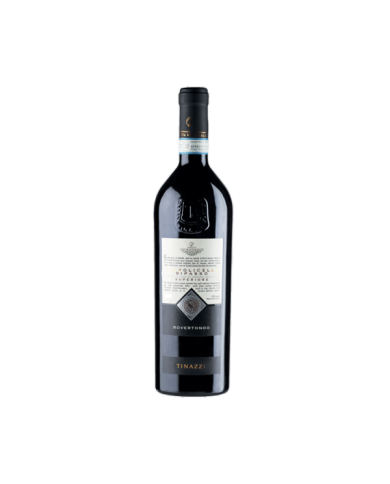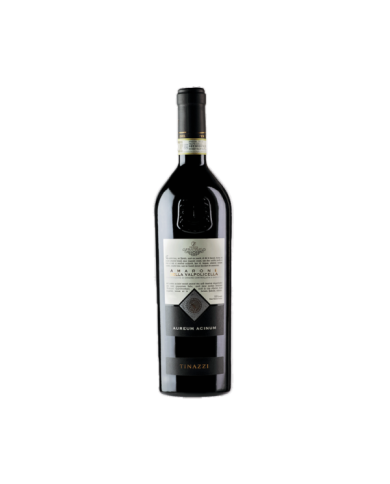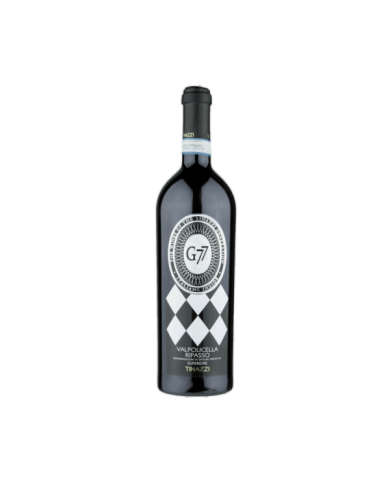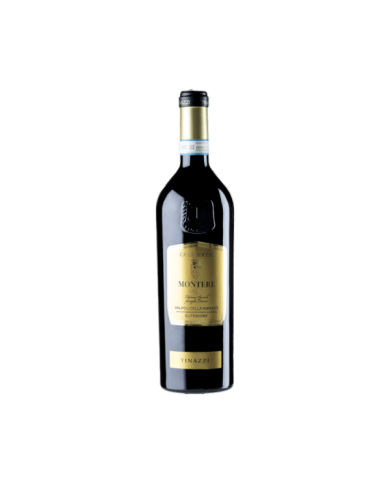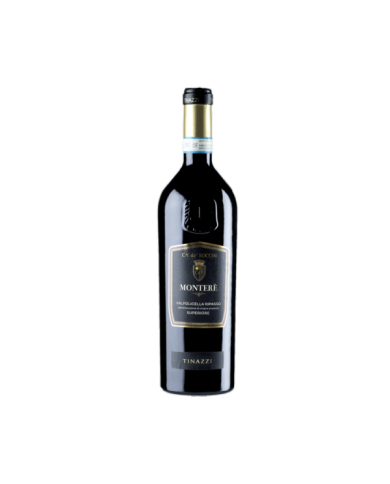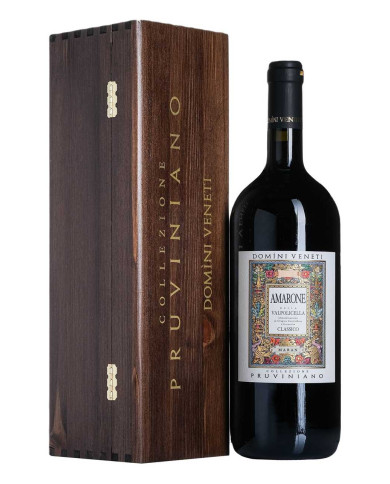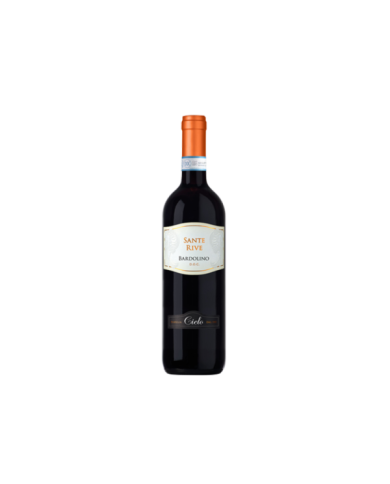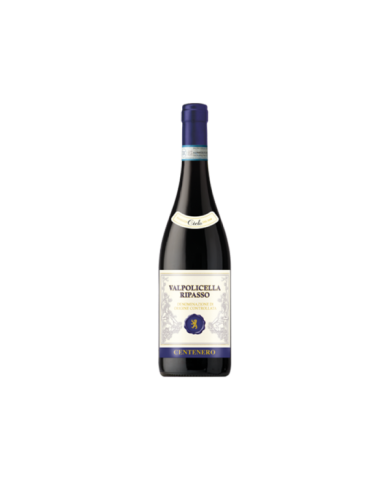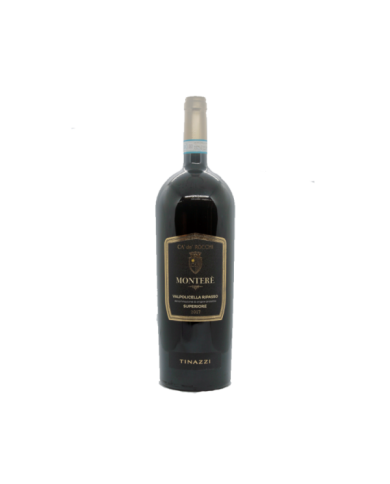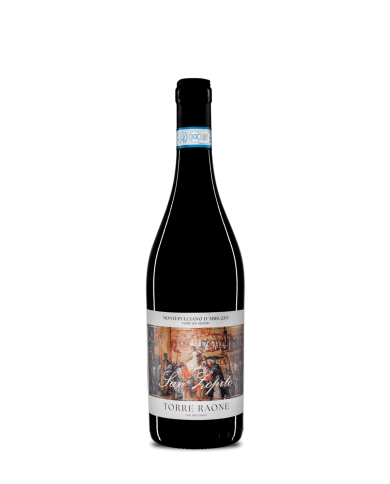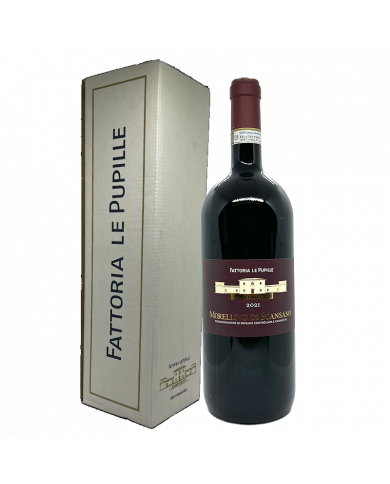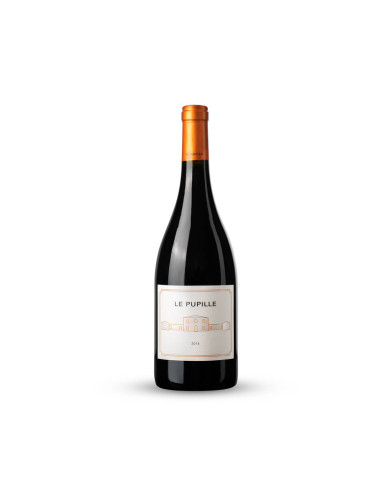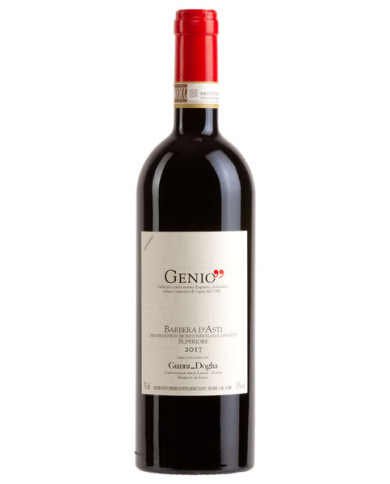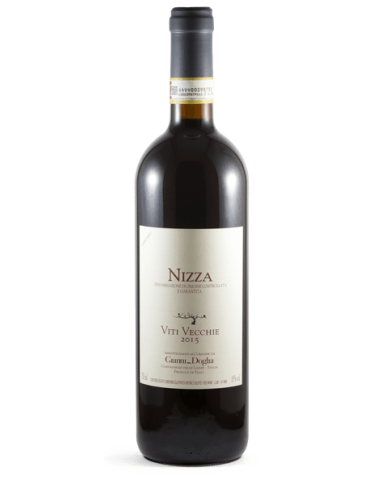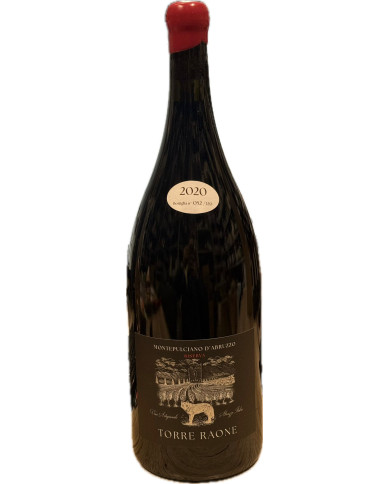Color Intense and full red. Bouquet Elegant, with hints of ripe red fruit in particular cherry and morello cherry. Spicy hints and a final of chocolate and licorice Taste Wine of remarkable structure and elegance, with the right balance between tannins and softness given by the concentration of glycerine Combinations Particularly indicated with important meat dishes, such as braised or stewed (for example the traditional braised meat with Amarone or the pastisada del caval). Also ideal with all aged cheeses. Serving temperature To be served at room temperature around 18/20 ┬░ C. To be uncorked at least an hour before being served
A special edition dedicated to the owner of the Tinazzi family business. Wine obtained from the best grapes of the 80% Corvina, 15% Rondinella and 5% Molinara varieties. It immediately enchants with sweet tones of cherries, plums, licorice and spices. Ripe tannins complete the excellent impression of the wine. The aftertaste is beautiful, very fruity and delicious.
Masterpiece of A50 wine, created in honor of the "king" of the Veronese vineyard - Andrea Tinazzi . Only 3000 bottles of this type worldwide with 24k gold caps, woven wool labels and Andrea Tinazzi 's hand sign.
On the nose you can perceive the characteristics of the native vines of Valpolicella and Verona, used for this fantastic blend: Corvina, Corvinone, Rondinella . These grapes give the wine intense notes of red fruit, in particular cherry, morello cherry, jam. We also perceive the tertiary aromas given by aging: 12 months in French and American oak barrels. Leather, chocolate, vanilla, with a slight balsamic note.
The Amarone "La Bastia" of the Ca 'De' Rocchi winery is a complex and articulated wine of an intense red color with garnet reflections. Fruity notes of cherry and plum emerge on the nose, as well as spicy, balsamic and chocolate hints. The taste, concentrated yet light, stands as an example of balance, finesse and elegance. Give every sip full-bodied emotions. Ages over 24 months in French and Slavonian oak barrels
Amarone della Valpolicella Classico dei Domìni Veneti is born in the historic area of Valpolicella Classica, from terraced vineyards interspersed with characteristic dry stone walls. Deeply concentrated garnet red. It is enhanced on the nose with hints of dried red fruit, tobacco and spices. The taste is surprisingly intense and decisive, with pure silk tannins. On the table it is perfect with braised meats and grilled meats, as well as with long-aged cheeses and game.
Grapes : Corvina, Rondinella, Molinara. Garnet red. Intense and persistent bouquet. Dry and velvety flavor with hints of cherry, robust but harmonious body. Serving temperature: 16 ┬░ C
It goes well with game, roasted red meats and aged cheeses.
Hints of vanilla and plum liqueur prepare a gustatory trajectory capable of combining sweetness and freshness, with silky tannins and a captivating drink
Gorgeous garnet color. Aromas of roasted beetroot, rosemary, sun dried tomato and ripe figs with a round, vibrant and fruity palate. Reduction flavors of pomegranate, chocolate and fresh coffee. Tasty finish, black olive. A balanced, complex Amarone with a rustic charm.
Valpolicella Denomination: A Journey into the Heart of Italian Wines
The Valpolicella Denomination is an authentic excellence of the Italian wine scene. Located in the Veneto region of northeastern Italy, Valpolicella is famous for its high-quality wines and rich winemaking tradition. In this article we will explore the history, the grape varieties, the production processes and the distinctive characteristics that make the Valpolicella Denomination so appreciated internationally.
Introduction to the Valpolicella Denomination
The Valpolicella Denomination is a winegrowing area in the Veneto region, known for the production of high quality wines. This denomination includes several areas, including Valpolicella Classica, Valpantena, Valpolicella Est, Valpolicella Valdadige and the Recioto della Valpolicella area. Each area contributes its own unique characteristics to the production of Valpolicella wines.
History and territory of Valpolicella
The history of viticulture in Valpolicella dates back to Roman times, but it is over the centuries that this region has acquired a reputation for winemaking excellence. The Valpolicella area is characterized by gentle hills, a Mediterranean climate and a soil rich in calcareous marl, gravel and clay. These geographical and climatic conditions offer an ideal environment for the cultivation of native vines.
Main grape varieties of Valpolicella
The Valpolicella denomination is distinguished by the use of native vines which give the wines a unique character. The main vines grown in the region are Corvina Veronese, Corvinone, Rondinella and Molinara. Corvina Veronese is the dominant grape variety, known for its contribution to the structure, color and complex aromas of Valpolicella wines.
Production process of Valpolicella wines
The production of Valpolicella wines follows a rigorous process that begins with the grape harvest, usually between September and October. After harvesting, the grapes are selected and placed in boxes to preserve their integrity. Subsequently, the grapes are gently pressed to obtain the must, which is fermented at a controlled temperature.
A distinctive aspect in the production of Valpolicella wines is the use of drying. A part of the grapes, in particular for the production of Amarone della Valpolicella and Recioto della Valpolicella , is dried in ventilated rooms for several months. During drying, the grapes lose part of their water, concentrating their sugars and aromas.
Types of Valpolicella wines
The Valpolicella Denomination includes different types of wines, each with its own unique characteristics. Among the best known we find:
- Valpolicella Classico: a young and fruity red wine, ideal for everyday consumption.
- Valpolicella Superiore: a more structured and complex wine, obtained from selected grapes and a longer aging period.
- Amarone della Valpolicella : a dry, intense and full-bodied red wine, obtained from dried grapes.
- Recioto della Valpolicella : a sweet and enveloping red wine, also produced from dried grapes.
Organoleptic characteristics of Valpolicella wines
Valpolicella wines are characterized by a vast range of aromas and flavours. The Valpolicella Classicos offer notes of fresh fruit, such as cherries and strawberries, with a pleasant freshness. More structured wines, such as Amarone della Valpolicella , have complex aromas of dried fruit, spices, tobacco and chocolate. Recioto della Valpolicella , on the other hand, is distinguished by its sweet aromas of ripe fruit, raisins and honey.
Culinary pairings with Valpolicella wines
Valpolicella wines lend themselves to multiple culinary combinations. The Valpolicella Classicos go well with pasta dishes, risottos, white meats and fresh cheeses. The Amarone della Valpolicella and the Recioto della Valpolicella go splendidly with red meats, roasts, aged cheeses and dark chocolate. The complexity and structure of these wines also make them ideal for meditation.
Visit Valpolicella and its cellars
For wine lovers, visiting Valpolicella and its cellars is an unforgettable experience. Numerous wineries offer guided tastings, vineyard visits and detailed explanations of the wine making process. These visits allow you to immerse yourself in the local wine culture, discover the secrets of the native vines and taste the wines directly from the producer.
The Valpolicella Denomination represents a real Italian enological treasure. Its millenary history, the native vines, the traditional production processes and the organoleptic characteristics of the wines have contributed to making it famous all over the world. If you are passionate about quality wines, you cannot miss the opportunity to taste the fine Valpolicella wines.
FAQ (Frequently Asked Questions)
What is the origin of the Valpolicella denomination?
The Valpolicella denomination has ancient origins in the Veneto region of Italy. Its history dates back to Roman times.
What are the main grape varieties used in the production of Valpolicella wines?
The main grape varieties used in the production of Valpolicella wines are Corvina Veronese, Corvinone, Rondinella and Molinara.
What are the best known types of Valpolicella wines?
The best known types of Valpolicella wines are Valpolicella Classico, Valpolicella Superiore, Amarone della Valpolicella and Recioto della Valpolicella .
What are the recommended food pairings for Valpolicella wines?
Valpolicella wines pair well with a variety of dishes. Valpolicella Classico goes well with pasta, risotto, white meats and fresh cheeses. Amarone della Valpolicella and Recioto della Valpolicella go wonderfully with red meats, roasts, aged cheeses and dark chocolate.
Is it possible to visit the Valpolicella cellars?
Yes, many Valpolicella wineries are open to the public and offer guided tours, tastings and the possibility of buying their wines directly on site.

